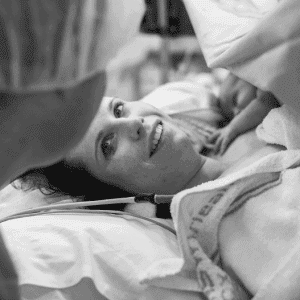Factsheet – Optimal Cord Clamping
Hannah Tizard
Research Midwife Blackpool Teaching Hospitals NHS Foundation Trust, Editor-in-Chief The Student Midwife Journal, Project Lead All4Birth and Founder BloodtoBbay.com
@midwifetiz
Summary
This factsheet is about ‘delayed’ and ‘optimal cord clamping’, which is also sometimes called ‘deferred’ cord clamping.
Clamping of the umbilical cord happens after your baby is born, usually before or when you birth your placenta in the final stage of labour (3rd stage). Sometimes women choose not to cut the umbilical cord and prefer to let this dry up and fall off naturally, this is called a ‘lotus birth’.
Delayed or optimal cord clamping are terms used to describe not cutting the umbilical cord straight away – because leaving it alone has many benefits for the baby. This article will provide you with information about the benefits, explaining what we know and will suggest practical tips to help you decide whether to include delayed or optimal cord clamping in your birth preferences.
What we know

Image credit: Shawnastanley.co
Approximately 33% of your baby’s total blood volume is in the placental unit (the placenta and the umbilical cord) at birth.1 When your baby is born, it is preferable to allow time for this blood to transfer (perfuse) to your baby, so that the baby can start life with its full volume of blood.2,3
Previously (over the last 50-60 years), babies had their cords cut immediately after birth (within the first minute) and this is called ‘early or immediate cord clamping’. We now know that immediate cord clamping is harmful to the baby, but unfortunately this practice still exists in some places.
At the present time, there are rare scenarios that can occur at birth, where the umbilical cord is clamped early. These reasons range from problems with the umbilical cord or placenta or may happen when a baby needs to be taken to a specialist piece of equipment (resuscitaire) to have help from a healthcare professional to start breathing. Some hospitals have bedside resuscitaires so healthcare professionals can provide the baby with important care whilst the umbilical cord remains attached. This is best practice, and will be discussed in another article.
New research indicates that rather than setting a particular time when the umbilical cord should be cut (the World Health Organisation suggests at least 3 minutes), it is better to assess the baby and the umbilical cord’s condition, this is known as physiological cord clamping or optimal cord clamping.4 When a baby is born, the baby usually (but not always) makes a spontaneous cry, sometimes the baby will need gentle rubbing to stimulate breathing and this is normal. The regular breathing or cries of a newborn achieves changes to the baby’s circulatory system, and the blood within the placental unit begins its transfer to the baby. You may notice your baby becoming pinker as the blood transfuses, the umbilical cord will eventually turn white and floppy when the process of blood transfer is complete. In a healthy term birth, the baby will usually be placed on your abdomen for skin to skin contact, whilst this transfer happens, we know this position does not negatively affect the transfer of blood.5 After this has completed, the umbilical cord can be safely cut at a time of your choosing.
Advantages of delayed and optimal cord clamping to the newborn
- The baby will receive up to 30% more of the fetal-placental blood than it would with immediate cord clamping.1
- The increase in warm blood reduces the impact of your baby getting cold (newborn hypothermia) alongside appropriate thermoregulatory care, such as, drying the baby and a hat.6,7
- An increase in blood volume promotes perfusion of blood to the baby’s lungs and brain, reducing the impact of lack of blood (hypovolaemia) and lack of oxygen (hypoxia) at birth.4
- Increased red blood cells (haemoglobin levels) improve oxygen and iron transportation around the baby’s body, this can reduce baby’s risk of anaemia in the first 12 months of life.8
- Iron is important for the long-term neurodevelopment of baby, because it supports myelination of axons and development of white matter in the brain.9
- Studies show improved fine motor function and social skills later in life. 8
- Immune promoting stem cells provide lifelong protection to baby.10
- Helps to keep the mother-baby together facilitates all the benefits of skin to skin for you and your baby.11
Significant benefits in preterm infants
- Improved transitional circulation.12
- Better establishment of red blood cell volume.12
- Decreased need for blood transfusion.12
- Lower incidence of a serious illness in which tissues in the intestine (gut) to become inflamed and start to die (necrotizing enterocolitis) and bleeds on the brain (intraventricular haemorrhage).12
Other health benefits associated with delayed and optimal cord clamping include: a reduced lifetime risk of developing chronic lung disease, asthma, diabetes, epilepsy, cerebral palsy, Parkinson’s disease, infection and abnormal tissue growths.13
What we don’t know
As previously suggested, within research there has been speculation over the time to clamp and cut the umbilical cord following birth. This has led to recognition about the importance of using individual physiology focussed practice through optimal cord clamping based on the baby and cord condition, importantly waiting until the cord has turned white.
Delayed umbilical cord clamping should not be confused with milking of the cord. The terms do not mean the same thing (milking refers to physically expressing blood from the umbilical cord). There are various recent studies assessing the effect of cord milking, practised at different times after birth, with a variety of “milking” times, associated with early or delayed cord clamping. These studies need further analysis, as cord milking has been proposed as an alternative to delayed cord clamping, especially for preterm infants.2 Many studies of cord milking show benefits but cord milking, especially at caesarean delivery as umbilical cord milking offers the primary advantage of speed but it should not be used as a substitution for delayed cord clamping, where time is not a factor.
With regard to clinical practice we also need to understand whether gaps in knowledge, skills, and technological support may delay the adoption and safe practice of physiological cord clamping.4
Available literature does not yet provide sufficient high-quality evidence to understand the effects of delayed cord clamping in babies with complications such as lack of oxygen during labour (intrapartum asphyxia), fetal growth restriction, or extreme prematurity.4
Mothers and families: how to use the evidence
- Ask your healthcare provider about optimal cord clamping. Discuss the timing of umbilical cord clamping. If a lower limit time period is suggested (1 minute) consider requesting an extended time based on the condition of the cord, i.e. waiting until it has turned white.
- If you are having a caesarean birth, it is likely that your healthcare provider may suggest delayed cord clamping of 1-2 minutes. The time is reduced for a number of factors, but research suggests the transfer of blood may occur more quickly at caesarean section and that babies achieve the benefits of the blood and iron stores despite the time being reduced.8 Healthcare practitioners are attentive to your wellbeing and sterility in an operating theatre, but this should not impact on your ability to achieve delayed cord clamping for your baby, unless an emergency situation occurs.
- The presence of light meconium in the waters (baby has opened its bowels before birth) should not impact on ability to have delayed cord clamping. If the meconium waters are heavy with large faecal particles present and the baby requires support at birth, the healthcare provider may wish to transfer baby to a resuscitaire for examination, in which case, unless bedside resuscitaires are available, early cord clamping will be necessary.
Midwives and birth workers: how to use the evidence
- Only cut and clamp the cord if the neonate’s heartrate is below 60bpm at birth, and you are unable to initiate resuscitation at the bedside with an intact cord.7
- Not many babies have a heart rate below 60bpm. Remember you must use the full first minute to dry, stimulate and assess the baby.7
- Standard midwifery practices such as taking cord gases & blood to assess RH- factor can be performed with an intact cord.15
- It’s a common belief that whilst we can feel the cord pulsate the blood transfer to baby is occurring. However, the presence of cord pulsations does not necessarily signify ongoing flow, and cessation of pulsations can occur with or without flow.16
- The argument concerning a very small increase in jaundice is not sufficient to withhold optimal cord clamping when the benefits of OCC are so prolific. Usual measures to monitor and treat jaundice continue without any change needed.2
Links to resources
 Articles
Articles
A physiologic approach to cord clamping: Clinical issues – https://www.ncbi.nlm.nih.gov/pmc/articles/PMC4823683/#CR30
Effect of Delayed Cord Clamping on Neurodevelopment at 4 Years of Age: A Randomized Clinical Trial.
 Film Audio
Film Audio
Penny Simkin on Delayed Cord Clamping
 Guidelines
Guidelines
Optimal timing of cord clamping for the prevention of iron deficiency anaemia in infants
NICE Intrapartum care for healthy women and babies Clinical guideline [CG190]
 Social Media
Social Media
Bloodtobaby Optimal cord clamping
Optimal cord clamping #waitforwhite
Umbilical Cord Clamping Concerns
 Websites
Websites
The Positive Birth Movement – Everything you need to know about Optimal Cord Clamping
Baby’s Blood Campaign Wait for white
References
- Yao A. Distribution of blood between infant and placenta after birth. The Lancet. 1969;294(7626):871-873. doi:10.1016/s0140-6736(69)92328-9
- WHO. Optimal timing of cord clamping for the prevention of iron deficiency anaemia in infants. World Health Organization. https://www.who.int/elena/titles/cord_clamping/en/. Published 2014. Accessed April 5, 2020.
- McDonald S, Middleton P, Dowswell T, Morris P. Effect of timing of umbilical cord clamping of term infants on maternal and neonatal outcomes. Cochrane Database of Systematic Reviews. 2013. doi:10.1002/14651858.cd004074.pub3
- Niermeyer S. A physiologic approach to cord clamping: Clinical issues. Matern Health Neonatol Perinatol. 2015;1(1). doi:10.1186/s40748-015-0022-5
- Vain N, Satragno D, Gorenstein A et al. Effect of gravity on volume of placental transfusion: a multicentre, randomised, non-inferiority trial. The Lancet. 2014;384(9939):235-240. doi:10.1016/s0140-6736(14)60197-5
- Oh W, Lind J. Body Temperature of the Newborn Infant in Relation to Placental Transfusion. Acta Paediatr. 1967;56(s173):137-145. doi:10.1111/j.1651-2227.1967.tb15289.x
- Wyllie J, Ainsworth S, Tinnion R. Resuscitation and support of transition of babies at birth. Resus.org.uk. https://www.resus.org.uk/library/2021-resuscitation-guidelines/newborn-resuscitation-and-support-transition-infants-birth Published 2020. Accessed April 5, 2020.
- Andersson O, Hellstrom-Westas L, Andersson D, Domellof M. Effect of delayed versus early umbilical cord clamping on neonatal outcomes and iron status at 4 months: a randomised controlled trial. BMJ. 2011;343(nov15 1):d7157-d7157. doi:10.1136/bmj.d7157
- Mercer J, Erickson-Owens D, Deoni S et al. Effects of Delayed Cord Clamping on 4-Month Ferritin Levels, Brain Myelin Content, and Neurodevelopment: A Randomized Controlled Trial. J Pediatr. 2018;203:266-272.e2. doi:10.1016/j.jpeds.2018.06.006
- Borlongan C, Lawton C, Acosta S et al. Enhancing endogenous stem cells in the newborn via delayed umbilical cord clamping. Neural Regen Res. 2015;10(9):1359. doi:10.4103/1673-5374.165218
- Moore E, Bergman N, Anderson G, Medley N. Early skin-to-skin contact for mothers and their healthy newborn infants. Cochrane Database of Systematic Reviews. 2016. doi:10.1002/14651858.cd003519.pub4
- ACOG. Delayed Umbilical Cord Clamping After Birth. Acog.org. https://www.acog.org/clinical/clinical-guidance/committee-opinion/articles/2017/01/delayed-umbilical-cord-clamping-after-birth. Published 2020. Accessed April 5, 2020.
- Tolosa J, Park D, Eve D, Klasko S, Borlongan C, Sanberg P. Mankind’s first natural stem cell transplant. J Cell Mol Med. 2010. doi:10.1111/j.1582-4934.2010.01029.x
- Andersson O, Hellström-Westas L, Domellöf M. Elective caesarean: does delay in cord clamping for 30 s ensure sufficient iron stores at 4 months of age? A historical cohort control study. BMJ Open. 2016;6(11):e012995. doi:10.1136/bmjopen-2016-012995
- Tizard H. Collecting cord gases with an intact cord. Bloodtobaby.com. https://www.bloodtobaby.com/post/collecting-cord-gasses-with-an-intact-cord. Published 2018. Accessed April 6, 2020.
- Boere I, Roest A, Wallace E et al. PS-316 Umbilical Blood Flow Patterns Directly After Birth Before Delayed Cord Clamping. Arch Dis Child. 2014;99(Suppl 2):A225.1-A225. doi:10.1136/archdischild-2014-307384.614









